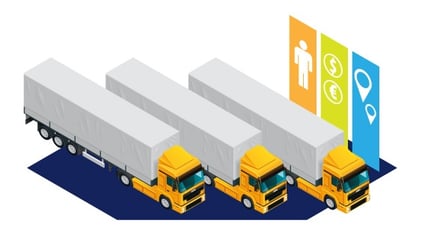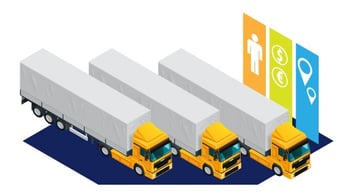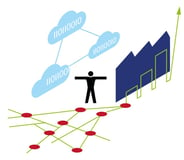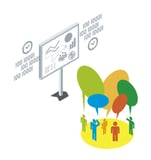How-to: Choosing the Right Logistics Technology
Brian Hoey - May 23, 2019

 Whether you’re a freight forwarder seeking out a new ERP system that helps to manage the flow of goods from origin to destination or a manufacturer looking to add visibility and bolster efficiency within your own transportation management processes, selecting the right logistics or transportation management software can be a difficult task. In some ways, the process of selecting the right technology is a lot like finding a 3PL (third party logistics provider) with whom to partner. In both instances, you need to consider price, customer service, existing relationships, and scalability—but you also need to take stock of your organization’s values and provide a clear roadmap for the future of you're your operations. Even if you choose the most reputable partner in the business, the partnership likely won’t be a success if their goals aren’t well-aligned with your own.
Whether you’re a freight forwarder seeking out a new ERP system that helps to manage the flow of goods from origin to destination or a manufacturer looking to add visibility and bolster efficiency within your own transportation management processes, selecting the right logistics or transportation management software can be a difficult task. In some ways, the process of selecting the right technology is a lot like finding a 3PL (third party logistics provider) with whom to partner. In both instances, you need to consider price, customer service, existing relationships, and scalability—but you also need to take stock of your organization’s values and provide a clear roadmap for the future of you're your operations. Even if you choose the most reputable partner in the business, the partnership likely won’t be a success if their goals aren’t well-aligned with your own.
Because choosing logistics technology is often one of the most impactful decisions a company make with regards to short- and mid-term operational planning, the stakes here are pretty high. Luckily, by taking a smart, measured approach it’s easy to avoid many of the pitfalls that go along with the selection process—whether that’s the risk of selecting technology that won’t scale with your business or creating a disjointed technological ecosystem that’s prone to silos and disfunction.
Examine Your Existing IT
For starters, let’s think a little about why you might be in the market for a new logistics solution. Presumably, it’s because your current IT environment either isn’t meeting your current needs, or it isn’t meeting any new needs that may be emerging. Some businesses might be finding (in the early days of the Logistics 4.0 era) that their existing software solutions don’t have the kind of analytical capabilities that they could use to gain value from their data streams. Conversely, other businesses might find that it’s difficult to centralize data streams (on routing, pricing, customer requirements, etc.) in the first place. In any event, you need to take a real look at your existing software and identify not just the gaps, but also the things that it does well. After all, you don’t want to lose out on functionality that you’re already making use of (unless your new software provider has some other functionality they can provide in its stead).
Eliminate Silos and Shadow IT
Okay, once you’ve figured out what your needs actually are in terms of software, it’s time to begin evaluating the various solutions that purport to meet those needs. Because openness and connectivity are increasingly important features across the entire logistics chain, the promotion of visibility should be a priority regardless of what other functionality you’re looking for. Why? Because without the ability to share data and make plans available to key stakeholders, your transport processes will still be subject to disconnect and, as a result, disruptions.
Thus, any product you evaluate should have a demonstrable ability to reduce silos and root out shadow IT. For the former, you should be able to assess the ease with you can access any given piece of operational information. This will depend on three things: How well-designed is the user interface? How effectively does the solution integrate with various data streams? And how easily does it let users share data with one another? For the latter, you’ll have to ascertain how easily it integrates with other solutions you may be using. Since Shadow IT tends to crop up when individual teams can’t integrate their own desired software or functionality within their broader ERP system, it’s crucial that whatever logistics technology you adopt plays well with other IT.
Consider Connectivity
We covered part of the relevant concerns for connectivity in the section on Shadow IT above, but the question of how well or poorly your new logistics technology connects with related IT infrastructure doesn’t end with the elimination of Shadow IT. In fact, it’s one of the most crucial criteria on which you can judge a new piece of technology. Why? Because you don’t just need to connect disparate touchpoints within your own organization, you also need to connect with your clients’ systems and, in relatively digitized contexts, integrate streams of data from IoT (internet of things) devices and RFID chips within your trucks, containers, pallets, etc. Let’s say, for instance, that you’re looking to optimize your loading and unloading of containers with a new digital solution; you won’t just want to see a diagram of the optimal organization of stock within a particular unit—rather, you’ll want to see how container space is actually being utilized, perhaps even in real-time; likewise, you’ll want to integrate your loading models with customer delivery expectations (so that, for instance, you can make sure that the earliest deliveries are loaded in such a way as to make them easy to retrieve without unloading and reloading a bunch of extraneous stock). If the logistics technology under consideration can’t offer this level of connectivity, it may prove more of a hindrance than a help.
Align Your Solution with Your Long Term Goals
Once you’ve answered the technical questions we posted above, it’ll be time to do some slightly-less-quantitative soul searching as a company. Ask yourself, where do you want your business to be in a year? Three years? Ten years? The answers to these questions will help guide you as you evaluate the various possibilities you’re considering. For instance, if Logistics 4.0 capabilities or the ability to connect with Industry 4.0-enabled clients is a high priority, you should make sure that your software provides for those eventualities. By the same token, if you’re looking to create a more holistic approach to transport management—in which route and tour planning, inventory management, and other related functions are managed synergistically—you should be certain that your chosen solution has the functionality to connect these processes in particular.
Logistics and transportation management are undergoing rapid changes, and the rate of change is only increasing. As your organization does its best to keep up or even lead the charge into uncharted territory, it’s crucial to select technology providers who will put you in the best position to do so. In effect, you’re generally choosing a business to partner with in the same way you would choose a supplier or a distributer, and as such you shouldn’t take the decision lightly.
LATEST POSTS
- Understand Circular Economy in The Manufacturing Industry
- How Can Industry 4.0 IT Integration Be Achieved Smoothly?
- The Significance of Order Sequencing in Discrete Manufacturing
- How to improve your Supply Chain Management: The Power of Control Towers
- Optimizing Human Resource Scheduling in Manufacturing: A Technological Approach



